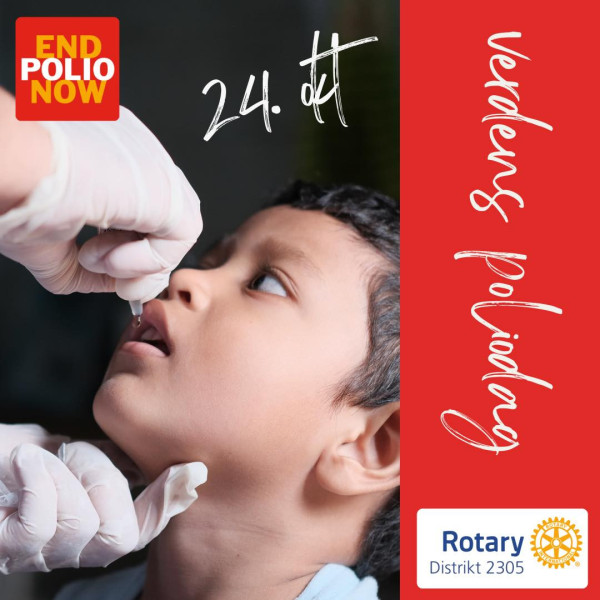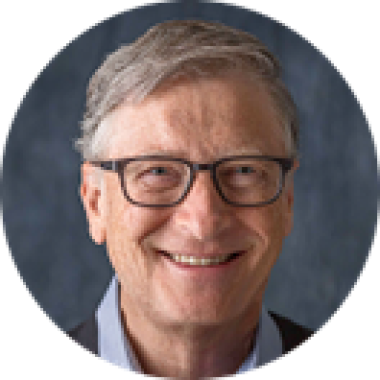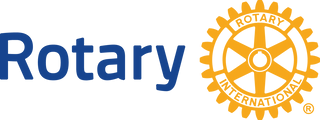Verdens Poliodag 24. oktober
Verdens Poliodag den 24. oktober markeres verden over av klubbene i Rotary. Rotary International er i førersetet når det gjelder bekjempelse og utryddelse av sykdommen Polio. Men det behøves penger til det viktige vaksinasjonsarbeidet. Støtt oss med VIPPS til 577258.

Bill Gates støtter arbeidet:
Gates, og Melinda og Bill Gates fond er en av de andre viktige medspillerne i denne kampen. Vaksinering er metoden som brukes for bekjempelse/ utrydding.
Resultatene som er oppnådd er fantastiske gode. Både Polio type-vill-2 og type-vill-3 er nå utryddet. Nå gjenstår kun Polio type-1 som forekommer i Afghanistan og Pakistan. I dag er vi svært nærme å kunne lykkes!
For hver 100-lapp vi i Rotaryklubbene samler inn til formålet, - vil Bill Gates legge til 100-lapper. Dvs våre 100 kroner blir til 300 kroner. Da monner det!
Støtt oss i dette arbeidet med VIPPS til Gjøvik Rotaryklubb, 577258.
Les et innlegg om saken fra Bill Gates her:
Vi er nærmere enn noensinne å utrydde polio
.

...Og nærmere enn noensinne å se en gjenoppblomstring. Av Bill Gates, publisert for 7 dager siden
Når folk flest i Amerika tenker på polio, tenker vi nok på president Franklin Delano Roosevelt. I 1921, i en alder av 39 år, ble han lammet av viruset og fikk aldri tilbake beina. Historien hans bidro til å gjøre polio til en nasjonal sak. Men på mange måter var opplevelsen hans en anomali.
Polio er tross alt i overveldende grad en barnesykdom, og de aller fleste tilfellene rammer de under fem år. Det var sant da FDR ble syk, og det er sant i dag. Den typiske pasienten er ikke en voksen med en allerede etablert politisk karriere – det er et lite barn, ofte et lite barn i et lavinntektsland, som kanskje aldri får sjansen til å ta sine første skritt.
Den urettferdigheten er en viktig grunn til at jeg har brukt de siste to tiårene på å utrydde polio. Den andre grunnen er at utryddelse faktisk er mulig, realistisk og innen rekkevidde. Dette er en sykdom vi kan bli kvitt – ikke bare kontrollere, men eliminere overalt. Det er en sjeldenhet innen global helse.
Verden har allerede gjort ekstraordinære fremskritt. Tilbake i 1988, da Rotary International og Verdens helseforsamling satte seg målet om utryddelse, lammet viruset mer enn 350 000 barn hvert år i 125 land. Siden den gang har tilfellene falt med 99,9 prosent. Stammene kjent som type 2 og type 3 vill poliovirus er utryddet. Hele det afrikanske kontinentet er sertifisert fritt for vill polio. Bare to land – Afghanistan og Pakistan – har fortsatt vedvarende overføring av type 1 vill poliovirus.
Nå er vi nærmere enn noensinne fullstendig utryddelse av polio. Men den siste milen viser seg å være den vanskeligste fordi virus finner måter å utnytte eventuelle immunitetshull eller svakheter. Der vaksinasjonsratene faller – selv kortvarig – kan de dukke opp igjen.
En av de største utfordringene kommer fra det som kalles variantutbrudd. I lokalsamfunn der immuniseringen er lav, kan det svekkede viruset som brukes i den orale poliovaksinen sirkulere asymptomatisk og i sjeldne tilfeller, over tid, mutere nok til å gjenvinne evnen til å forårsake lammelse hos uvaksinerte barn.
Selv om de fleste variantutbrudd skjer på steder med ekstremt lav vaksinasjonsdekning, dårlige sanitærforhold og svakere helsesystemer, er ingen steder risikofrie før verden er poliofri. I 2022 bekreftet USA sitt første tilfelle av lammelse av polio på nesten et tiår , og viruset ble oppdaget i avløpsvannsprøver fra New York. I tiden siden har varianter av poliovirus også blitt funnet i Storbritannia, Ukraina, Indonesia og andre land.
Den gode nyheten er at dagens verktøy er bedre enn noe vi hadde for bare fem år siden, og de sørger for at hver krone som brukes på saken går lenger enn noen gang før. Vi har en ny oral vaksine, nOPV2, som har langt mindre sannsynlighet for å mutere og føre til nye variantutbrudd; nesten to milliarder doser har allerede blitt gitt over hele verden. Nye regionale laboratorier i Ghana, Nigeria, Sør-Afrika og Uganda som tester avløpsvannsprøver og sekvenserer virus har redusert deteksjonstiden med over 30 prosent, noe som gir helsearbeidere et kritisk forsprang på utbruddsresponsen. Og overvåkingsnettverket for polio er et av de mest sofistikerte som noen gang er bygget – og bidrar også til å varsle helsepersonell om utbrudd av kolera, meslinger, ebola og til og med COVID-19 på høyden av den pandemien.
Gates Foundation har vært stolte av å støtte disse fremskrittene som en del av Global Polio Eradication Initiative , en koalisjon mellom WHO, UNICEF, CDC, Gavi, Rotary International og dusinvis av lands regjeringer. Det er et av de mest vellykkede samarbeidene i den globale helsehistorien.
Men akkurat nå står GPEI overfor et finansieringsgap på 1,7 milliarder dollar , ettersom diverse langsiktige giverland som har kuttet ned støtten sin. Uten de riktige ressursene må vaksinasjonskampanjer kanskje reduseres, overvåkingssteder vil sannsynligvis stenge, og viruset kan spre seg globalt.
I århundret siden FDR ble lammet av viruset, har amerikansk lederskap og generøsitet bidratt til å gjøre polio til en kamp hele verden kunne vinne. Fra March of Dimes, som finansierte forskning, til utviklingen av de første vaksinene, til støtte for utryddelseskampanjer, har amerikansk engasjement vært avgjørende.
Verden står på randen av å utrydde denne forferdelige sykdommen, og innsatsen i dette øyeblikket kunne ikke vært høyere. Hvis vi fullfører jobben, frigjør vi milliarder av dollar til andre helseprioriteringer og – viktigst av alt – beskytter vi generasjoner av barn mot et virus som har lammet millioner. Hvis vi gir etter fra kampen, kan opptil 200 000 barn bli lammet hvert år innen et tiår.
Vi har de vitenskapelige verktøyene og infrastrukturen som trengs for å krysse målstreken. Og vi har hundretusenvis av engasjerte vaksinatører som er fast bestemt på å få oss dit – som går fra dør til dør gjennom ørkener, jungler, flomsletter og krigssoner for å sørge for at ingen barn blir savnet. Jeg har møtt dem, jeg har hørt historiene deres, og jeg har sett hvor fast bestemt de er på å fullføre jobben.
Det burde vi også være.
14. august 2024
Klubbmøte - Presidentens møte 14. aug. 2024
Rotarymøte 2024-08-14
Presidentens møte. Vår nye president, Rune Skyberg, ønsket velkommen og viste så en videopresentasjon av ny internasjonal Rotary president Stephanie A. Urchick.
12. august 2024
Vennskapsklubben i Litauen feiret 10-årsjubileum
Gjøvik Rotaryklubb sin vennskapsklubb i Litauen, Anyksciai Rotary Club, feiret nylig sitt 10-årsjubileum. I denne sammenheng besøkte en delegasjon fra vår klubb Anyksciai og hadde med seg hilsener og gaver. De ble svært godt mottatt og deltok i feiringen.
12. august 2024
Rotaryårets første møte - kaffemøte
President Rune Skybak ønsket den 7. august velkommen til det første møtet i et nytt Rotaryår. Han ledet oss med stø hånd gjennom det første møtet og bebudet at i neste møte ville han komme med program for høsten og målsettinger for dette Rotary-året.
20. juni 2024
Sommeravslutning med presidentskifte
Gjøvik Rotaryklubb hadde grillaften med sommeravslutning den 19. juni. Samtidig ble det gjennomført presidentskifte. I en høytidelig del av møtet overrakte president Thor Åge Bergan klubbe og presidentkjede til påtroppende klubbpresident Rune Skybak.
26. mai 2024
GOBB - Gjøvik og Omland BoligByggelag - ved Tom Søgaard
Den 22. mai fikk vi et engasjerende foredrag av administrerende direktør Tom Søgaard i Gjøvik og Omland BoligByggelag. Det var godt oppmøte og mange spørsmål ble stilt til foredragsholderen.
18. april 2024
Nobels litteraturpris til jon fosse - hvorfor?
Høsten 2023 fikk Jon Fosse Nobels litteraturpris. Da var det mange ti-år siden sist en norsk forfatteren fikk denne hederen. Men hvorfor fikk Jon Fosse prisen? Det kunne Kjell Nygård fortelle oss alt om i et meget engasjerende foredrag.
22. mars 2024
CC-Gjøvik, Byens store kjøpesenter
Kveldens hovedpost var ved Vibeke Askevold som er Markedssjef for CC Eiendom AS og Leder for CC Markedsteam. Hun ga oss et meget interessant og engasjerende foredrag om kjøpesenterdrift. Hun ble da også bombadert med spørsmål fra tilhørerne!
15. februar 2024
TRF; Rotarys viktige og sentrale fond
TRF (The Rotary Foundation), Rotary-fondet, er organisasjonens sentrale og svært viktige fond. Hvert år betaler vi inn midler til dette fondet, og senere kan klubbene søke om midler til å finansiere større prosjekter. Fondet har gjennom årene betydd mye!
8. februar 2024
Kaffemøte med Rotarystoff
God oppslutning om klubbmøtet på onsdag 7. februar. Dette var et kaffemøte med Rotarystoff.
31. januar 2024
Klubbmøte - besøk av Anne Karin Jønnes
Besøk av Stortingsrepresentan Anne Karin Jønes (H) og refleksjoner rundt arbeidet på Stortinget
